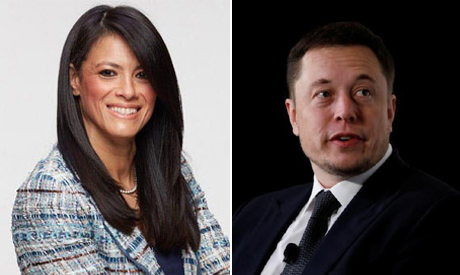http://english.ahram.org.eg/NewsContent/1/64/375744/Egypt/Politics-/Egypt-invites-Elon-Musk-to-visit-Giza-Pyramids-fol.aspx
Egypt invites Elon Musk to visit Giza Pyramids following controversial tweet
Musk's tweets claim the Great Pyramid of Khufu was built by aliens and Pharaoh Ramses II was an alien

Musk tweeted on Friday that "Aliens built the pyramids obv (obviously)." before adding in another tweet the great Egyptian Pharaoh Ramses II was an alien.
"The Great Pyramid was the tallest structure made by humans for 3,800 years. Three thousand, eight hundred years," Musk, who has more than 37 million followers, wrote in the following tweet.
Musk, 49, is a South African-born American entrepreneur and businessman who founded X.com in 1999 (which later became PayPal), SpaceX in 2002 and Tesla Motors in 2003. He became a multimillionaire in his late 20s when he sold his start-up company, Zip2, to a division of Compaq Computers.
Musk made headlines in May 2012, when SpaceX launched a rocket to send the first commercial vehicle to the International Space Station.
El-Mashat replied to Musk's tweet on Saturday morning indirectly rebuffing his claims and inviting him to visit the Great Pyramids to check out the tombs of pyramid-builders.
"I follow your work with a lot of admiration. I invite you & Space X to explore the writings about how the Pyramids were built and also to check out the tombs of the pyramid-builders. Mr Musk, we are waiting for you @elonmusk," El-Mashat, former minister of tourism, wrote.
The Great Pyramids, which dominate the Giza Plateau, are among the most popular touristic destinations in the world. Each of these spectacular structures served as the final resting place of a king of the Fourth Dynasty (c. 2613-2494 BC). The Great Pyramid of Giza was built for King Khufu (c. 2589-2566 BC), and the other two for Khafre and Menkaure, Khufu's son and grandson, respectively.
Khufu's pyramid, the oldest monument on the list of the Seven Wonders of the Ancient World, is both the oldest and largest of the three, and the first building to exceed it in height would not be built for another 3,800 years.
Famous Egyptologist and former minister of antiquities Zahi Hawass responded to the outlandish claims in a one-minute video saying Musk's are "complete hallucination". Hawass added in a written statement that all the archaeological, historical and linguistic pieces of evidence prove that the "Pyramids were built by the Egyptians."
The pyramid-builders' tombs prove the Great Pyramid was Egypt's national project and that it took them 32 years to build it, he stressed.
"All the tombs around the Great Pyramids mentioned the Khufu Pyramid and the king himself," Hawass said in the video.
In his written statement, Hawass added that the Great Pyramid of Khufu was one of the pyramids built between the third and 18th dynasties.
Inside the Great Pyramid of Khufu inscriptions tell about the "workmen and gangs" who built the Pyramids, Hawass added.
"There are also Wadi El-Jarf papyri that tell us for the first time about Khufu and building the pyramid," he added.
Wadi El-Jarf papyri are a collection of King Khufu's papyri discovered in 2013 at Wadi El-Jarf port, 24km south of the Zaafarana area and 119km from the city of Suez, by a Franco-Egyptian mission led by French Egyptologist Pierre Tallet and Egyptian Egyptologist Sayed Mahfouz.
"The Wadi El-Jarf papyri revealed the chief of staff 'Murar' told us about building the pyramid and cutting quarries from Turah area," Hawass said.
The papyri, the oldest known examples of Egyptian writing, provide an everyday account of the pyramid-builders who, during the reign of Fourth Dynasty King Khufu, transported limestone blocks from the quarries of Turah on the east bank of the Nile to the Great Pyramid at the Giza Plateau through the Nile and its canals.
They also show the workers at Wadi El-Jarf port participated in the construction of the Great Pyramid in Giza, indicating a highly efficient administrative system during Khufu's reign.
On King Ramses II, Hawass stated that evidence proves the king is from the Egyptian Delta's Sharqiya governorate and his family lived in "Per-Ramses" (a Pharaonic name meaning House of Ramses) that is currently Qantir village, 5.6 miles north of Faqous in Sharqiya and 60 miles northeast of Cairo.
-- Sent from my Linux system.
No comments:
Post a Comment